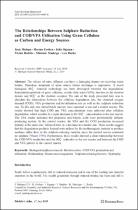 ResearchSpace
ResearchSpace
Relationships between sulphate reduction and COD/VFA utilisation using grass cellulose as carbon and energy sources
JavaScript is disabled for your browser. Some features of this site may not work without it.
- ResearchSpace
- →
- Research Publications/Outputs
- →
- Journal Articles
- →
- View Item
| dc.contributor.author |
Mulopo, J

|
|
| dc.contributor.author |
Greben, H

|
|
| dc.contributor.author |
Sigama, J

|
|
| dc.contributor.author |
Radebe, V

|
|
| dc.contributor.author |
Mashego, M

|
|
| dc.contributor.author |
Burke, L

|
|
| dc.date.accessioned | 2010-10-25T13:50:16Z | |
| dc.date.available | 2010-10-25T13:50:16Z | |
| dc.date.issued | 2010-07 | |
| dc.identifier.citation | Mulopo, J, Greben, H, Sigama, J et al. 2010. Relationships between sulphate reduction and COD/VFA utilisation using grass cellulose as carbon and energy sources. Applied Biochemistry and Biotechnology, Vol. 162, pp 1-11 | en |
| dc.identifier.issn | 0273-2289 | |
| dc.identifier.uri | http://www.springerlink.com/content/r738v5p143662882/fulltext.pdf | |
| dc.identifier.uri | http://hdl.handle.net/10204/4504 | |
| dc.description | Copyright: 2010 Human Press (Springer). This is a post print version of the work. The definitive version is published in Applied Biochemistry and Biotechnology, Vol. 162 | en |
| dc.description.abstract | The release of mine effluents can have a damaging impact on receiving water bodies. Therefore, treatment of mine waters before discharge is imperative. A novel biological SO2/4 removal technology has been developed whereby the degradation/fermentation products of grass cellulose, volatile fatty acids (VFA), function as the electron donors and SO2/4 as the electron acceptor. The aim of the study presented here was to elucidate the interactions between the cellulose degradation rate, the chemical oxygen demand (COD), VFA production and its/utilisation rate as well as the sulphate reduction rate. To this end, two stirred batch reactors were operated: a test and a control reactor. The results showed that high COD and VFA concentrations were achieved after cellulose degradation, which resulted in a rapid decrease in the SO2/4 concentration in the test reactor. The VFA results indicated that propionic and butyric acids were preferentially utilised, producing acetate. In the control reactor, the VFA and the COD production increased initially at the same rate, followed later by a decrease at a similar rate. These results suggest that the degradation products formed were utilised by the methanogenic bacteria to produce methane rather than by the sulphate-reducing bacteria, since the control reactor contained no sulphate (Visser 1995). Furthermore, these results showed a clear relationship between the COD/VFA production and the SO2/4 reduction in the test reactor and between the COD and VFA pattern in the control reactor. | en |
| dc.language.iso | en | en |
| dc.publisher | Humana Press (Springer Imprint) | en |
| dc.relation.ispartofseries | Journal Article | en |
| dc.subject | Biological sulphate removal | en |
| dc.subject | Batch reactors | en |
| dc.subject | COD/VFA production | en |
| dc.subject | Rumen microorganisms | en |
| dc.subject | Sulphate reducing bacteria | en |
| dc.subject | Syntrophy | en |
| dc.title | Relationships between sulphate reduction and COD/VFA utilisation using grass cellulose as carbon and energy sources | en |
| dc.type | Article | en |
| dc.identifier.apacitation | Mulopo, J., Greben, H., Sigama, J., Radebe, V., Mashego, M., & Burke, L. (2010). Relationships between sulphate reduction and COD/VFA utilisation using grass cellulose as carbon and energy sources. http://hdl.handle.net/10204/4504 | en_ZA |
| dc.identifier.chicagocitation | Mulopo, J, H Greben, J Sigama, V Radebe, M Mashego, and L Burke "Relationships between sulphate reduction and COD/VFA utilisation using grass cellulose as carbon and energy sources." (2010) http://hdl.handle.net/10204/4504 | en_ZA |
| dc.identifier.vancouvercitation | Mulopo J, Greben H, Sigama J, Radebe V, Mashego M, Burke L. Relationships between sulphate reduction and COD/VFA utilisation using grass cellulose as carbon and energy sources. 2010; http://hdl.handle.net/10204/4504. | en_ZA |
| dc.identifier.ris | TY - Article AU - Mulopo, J AU - Greben, H AU - Sigama, J AU - Radebe, V AU - Mashego, M AU - Burke, L AB - The release of mine effluents can have a damaging impact on receiving water bodies. Therefore, treatment of mine waters before discharge is imperative. A novel biological SO2/4 removal technology has been developed whereby the degradation/fermentation products of grass cellulose, volatile fatty acids (VFA), function as the electron donors and SO2/4 as the electron acceptor. The aim of the study presented here was to elucidate the interactions between the cellulose degradation rate, the chemical oxygen demand (COD), VFA production and its/utilisation rate as well as the sulphate reduction rate. To this end, two stirred batch reactors were operated: a test and a control reactor. The results showed that high COD and VFA concentrations were achieved after cellulose degradation, which resulted in a rapid decrease in the SO2/4 concentration in the test reactor. The VFA results indicated that propionic and butyric acids were preferentially utilised, producing acetate. In the control reactor, the VFA and the COD production increased initially at the same rate, followed later by a decrease at a similar rate. These results suggest that the degradation products formed were utilised by the methanogenic bacteria to produce methane rather than by the sulphate-reducing bacteria, since the control reactor contained no sulphate (Visser 1995). Furthermore, these results showed a clear relationship between the COD/VFA production and the SO2/4 reduction in the test reactor and between the COD and VFA pattern in the control reactor. DA - 2010-07 DB - ResearchSpace DP - CSIR KW - Biological sulphate removal KW - Batch reactors KW - COD/VFA production KW - Rumen microorganisms KW - Sulphate reducing bacteria KW - Syntrophy LK - https://researchspace.csir.co.za PY - 2010 SM - 0273-2289 T1 - Relationships between sulphate reduction and COD/VFA utilisation using grass cellulose as carbon and energy sources TI - Relationships between sulphate reduction and COD/VFA utilisation using grass cellulose as carbon and energy sources UR - http://hdl.handle.net/10204/4504 ER - | en_ZA |





